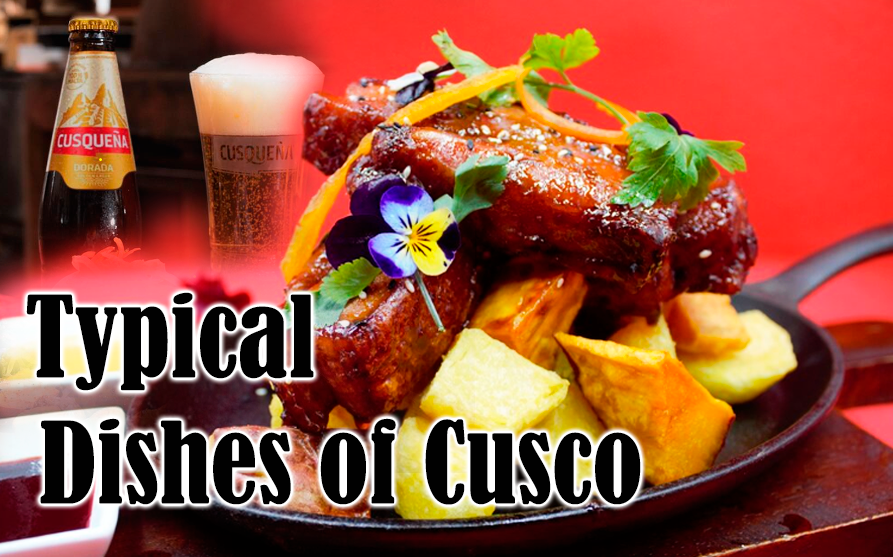
Exploring the cultural essences of Peruvian communities becomes a truly exquisite experience when tasting the typical dishes of Cusco, it is proud to offer visitors some of the most distinguished and delicious dishes in the country.
Over the years, many traditional dishes have evolved. However, the renowned spicyrías and chicherías have firmly maintained their cultural roots. In countless restaurants, these dishes native to Cusco are elegantly displayed, offering diners a unique experience with the culinary authenticity that characterizes Cusco.
The 10 typical dishes of Cusco that you should try:
1° Chiri Uchu “cold dish”
A culinary gem that stands out in Cusco cuisine, it is a widely recognized emblematic typical dishes of Cusco. Its name, which means “cold chili”, perfectly describes this delicious stew that is served at low temperature and is especially enjoyed during the Corpus Christi festivities, celebrated in the month of June.
This unique delicacy presents a masterful fusion of flavors and textures. Among its ingredients include baked guinea pig, boiled chicken, mountain sausage, fresh cheese, toasted corn, rocoto, trout, eggs, green onion, blood sausage, cochayuyo or seaweed, chorizo, chicken broth, charqui or chalona, and a tortilla made with corn flour.
Culinary magic unfolds when all of these elements are boiled and combined, expertly served in a single dish, providing a unique and delicious sensory experience. Chiri Uchu, more than a dish, is a culinary expression that encapsulates the rich tradition and festivity of Cusco.
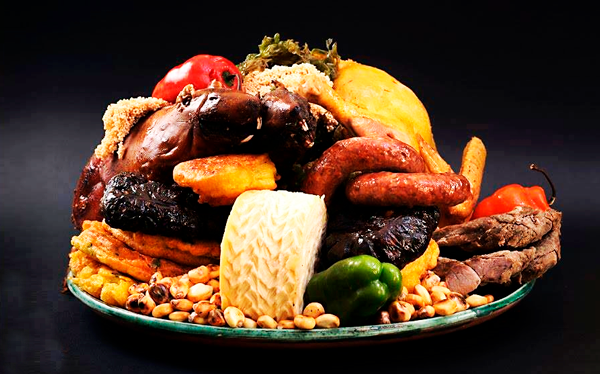
2° The Chicharrón a la cusqueña is the most typical dish of Cusco
The magic of this dish begins with the tender pork, skillfully chopped and browned in its own fat. The skill lies in the gradual browning process, which elevates the texture and flavor to new levels of culinary pleasure.
Once the meat reaches golden perfection, it is expertly cut and seasoned, then served accompanied by crunchy corn kernels, golden potatoes, and mint. This dish, rooted in local traditions, is also shared at festivities and religious events such as Qoyllur Riti.
This is one of the most sought after dishes in the city of Cusco, by both national and foreign tourists.
Where to eat the famous Cusco chicharrón dish if you are visiting Cusco
While in Cusco, the best place to find chicharrón is in the Saylla District. If you’re searching closer to the main square, we recommend establishments on Pampa del Castillo Street.
Saylla is the most popular district in the city of Cusco for the production of chicharrones, and it is located just a half an hour from the central part of the city of Cusco.
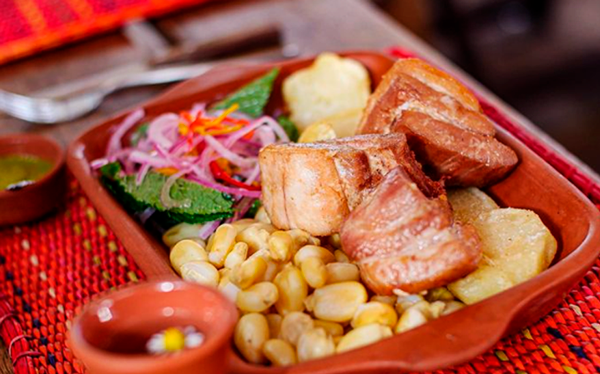
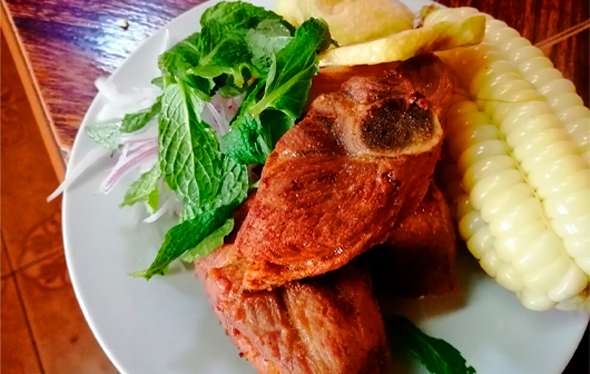
3° Chairo, a delicious typical dish from Cusco
Chairo emerges as a culinary treasure rooted in the traditions of the Andean highlands. This recipe, which transcends generations, is carefully composed of typical ingredients of the region, resulting in a thick and delicious soup designed to face cold days with the comforting embrace of flavor.
The preparation of Chairo is a celebration of the richness of local ingredients. Among the elements that make up this soup are native potatoes, quinoa, chuño (dehydrated potato), and beef. These ingredients intertwine within the pot to create a symphony of flavors that capture the very essence of the region.
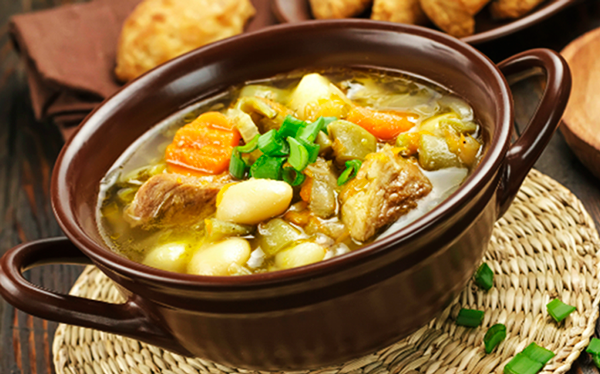
4° Cusco Fried Trout: A feast of freshness and traditional flavor
The emblematic Fried Trout of Cusco is made with the delicacies of the sea and rivers. This typical dish of Cusco can be enjoyed with both river trout and sea trout, offering a unique experience in each preparation.
Presented in its fried form, this delicacy is served with rice and cassava, creating a fusion of flavors that awakens the senses and captivates the palate. Those who want an even more intense experience can add the distinguished Creole Sauce, elevating Cusqueña Fried Trout to new culinary heights.
A valuable tip for authenticity seekers is to explore the cozy country restaurants around Cusco located near the rivers. Here, the freshness of the trout stands out, as it is often caught at the perfect moment to guarantee its deliciousness.
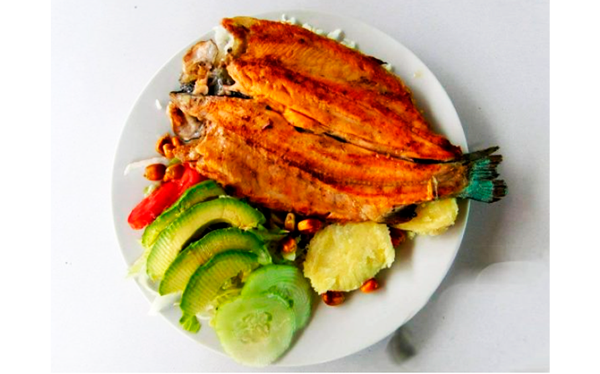
5° .- Quinoa Soup: A Light Feast for the Heights
In the heart of Cusco, where culinary diversity flourishes, soups are featured prominently. Among the options that capture the essence of typical dishes of Cusco, quinoa soup stands out as an optimal choice.
This soup, prepared with wheat, quinoa and pumpkin, often becomes the favorite of visitors in the colder seasons. Its lightness and exquisite flavor make it a comforting option, ideal to enjoy during the cool days that characterize the region.
For those who arrive in the Inca City and are in the acclimatization process, quinoa soup is a supportive delight. Its ability to ease digestion, and its light nature, make it a perfect ally for those who want to experience local flavors without overwhelming their system.
Thus, quinoa soup not only satisfies the appetite, it also stands out as a healthy and delicious option; a dish that fuses Cusco traditions with the nutritional benefits of quinoa.

6° .- Baked Cuy: The Iconic Face of the Peruvian Sierra
Among the mountains of Cusco, Cuy al Horno (Baked Cuy) emerges as an Andean typical dishes of Cusco that celebrates the culinary richness of the region. The guinea pig, an emblematic ingredient of the Peruvian mountains, becomes the protagonist of this traditional delicacy.
The meticulous preparation of this dish begins with the guinea pig, which must undergo a thorough cleaning process before being immersed in boiling water. It is then garnished with a blend of carefully selected seasonings, before being baked in the oven.
This Andean delicacy, rich in flavor and tradition, is presented accompanied by rice, potatoes, Creole salad and fried yuquitas, creating a combination of flavors that highlights the diversity and authenticity of Cusco gastronomy. To complete the experience, drink options include chicha de jora or morada.
Cuy al Horno not only feeds the body, it also tells stories of the Peruvian mountains, connecting diners with traditions rooted in culinary culture.
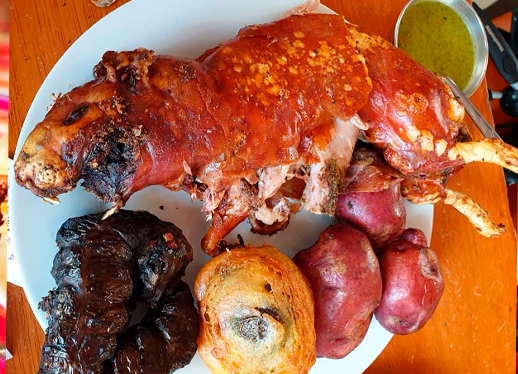

7°.- Mushroom Kapchi (Delicious Snack): A delicacy of the typical dishes of Cusco and in the Quintas Cusqueñas
Mushrooms, revered by the Incas and continually acclaimed by the most distinguished palates, are the undisputed protagonists of this dish that embodies the richness of the typical dishes of Cusco
This delicacy, intended to provide comfort in the cold winters of the mountains, emerges as a nutritious option as well as a special delight for lovers of vegetarian cuisine.
The carefully selected ingredients for Mushroom Kapchi include fresh mushrooms, broad beans, onion, ají panca, potatoes, olive oil, milk, cheese and huacatay. The combination of these elements creates a symphony of flavors and textures that highlights the authenticity of Cusco gastronomy.
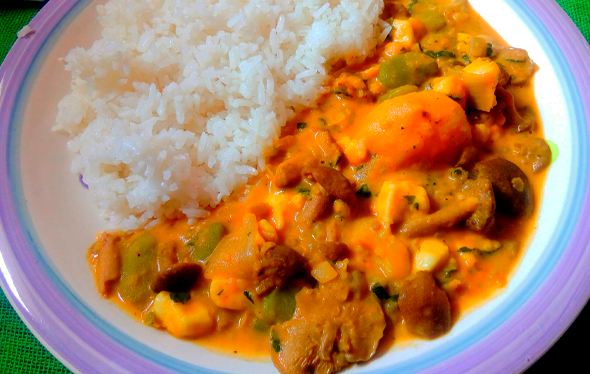
8° .- Corn with Cheese: A Traditional Snack in all Corners of Cusco
When your appetite awakens while you wander the charming streets of Cusco, the classic Choclo con Queso (corn with cheese) will always greet you on every corner as an irresistible snack.
Despite being one of the simplest dishes to prepare in Cusco cuisine, the quality of the corn is a determining factor in guaranteeing an exceptional flavor experience. The true magic of this treat lies in the perfect balance between the sweetness of the corn and the saltiness of the cheese.
The best Choclo con Queso can be found in the Sacred Valley of the Incas, in a town called Urubamba, a place of significant historical value. This typical dishes of Cusco, served as an appetizer, transcends its simplicity to become one of the most important icons of Peruvian cuisine.
When hunger strikes unexpectedly, there is no better option than to delight in this traditional snack.

9°.- Suckling pig baked in Cusco: a typical dish of Cusco considered as a banner dish of the Patron Saint Festivities.
In the typical patron saint festivities of Cusco, there is an indisputable protagonist that is never missing: Baked Lechón. This traditional dish, smaller than chicharrón, has become a culinary jewel in the imperial city, present in all restaurants and for all celebrations.
The meticulous preparation of this delicacy begins with the complete seasoning of the pig, inside and out. The harmonious combination of salt, pepper, cumin, ground garlic, mustard, oregano, chicha de jora, fresh yellow chili, ground mirasol chili and ground panca chili creates a flavor profile that highlights the authenticity of Cusco gastronomy.
After receiving its seasoning, the pig rests for a day, allowing the flavors to meld. The following day, the pig is placed in the oven, where it is transformed into a culinary masterpiece.
Although this typical dishes of Cusco dish may take longer to digest, its irresistible flavor and the authenticity it brings to the festivities make it a choice that will surely not disappoint.
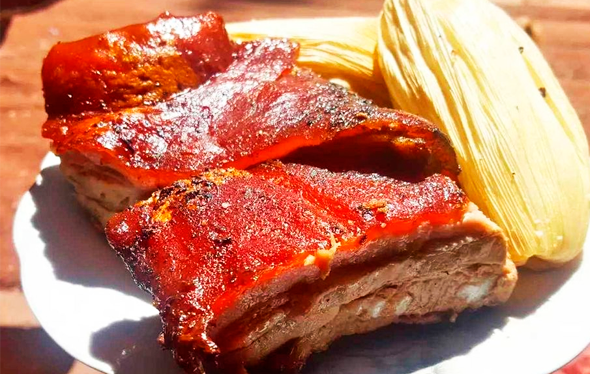
10°.-Zarza de Patitas: The Classic Accompaniment to the Cusco Seasoning
In the heart of Cusco, Zarza de Patitas is presented as an exquisite delicacy from the “navel of the world.” This dish, easily accessible in the city’s restaurants offering spicy fare, has become the classic companion that enhances the classic Cusco seasonings.
The main ingredient that gives life to this delicacy are pig’s feet. Accompanied by onions, garlic, bay leaf, canchan potato, tomato, vegetable oil, parsley, mint, pepper and oregano to taste.
La Zarza de Patitas not only delights the palate, but also tells stories of the region, connecting diners with the culinary roots of Cusco. Each bite is a sensory journey that celebrates the authenticity and exquisite nature of Cusco seasoning.
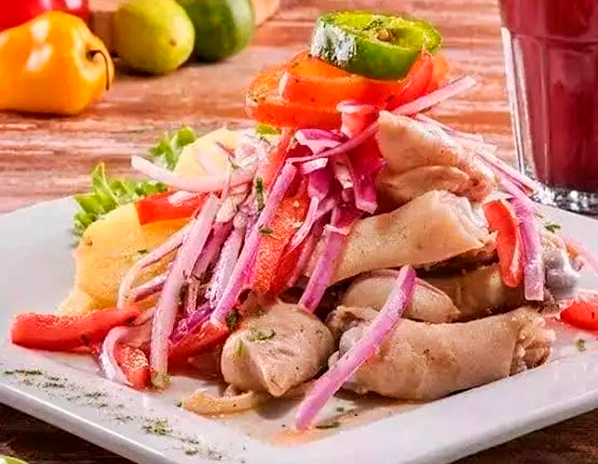
Typical drinks to accompany the traditional dishes of Cusco
Aqha or Chicha de Jora: The Yellow Nectar Inherited from the Inkanate
Rooted in the traditions of the Inkanato, Aqha or Chicha de Jora, also known as yellow chicha, is an alcoholic beverage that has endured over time. It is derived from dried and sprouted yellow corn.
The yellow corn, once germinated and ground, is carefully boiled. The resulting liquid is filtered through baskets made with reed and ichu or wild straw reeds, ensuring the purity and quality of the chicha. Subsequently, the liquid is fermented for three days in rakis or ceramic vessels, resulting in a drink that has approximately 3% alcohol content at the end of the process.
Aqha or Chicha de Jora is not just a drink; It is a bridge that unites the present with the past, transporting those who enjoy it to ancient times.
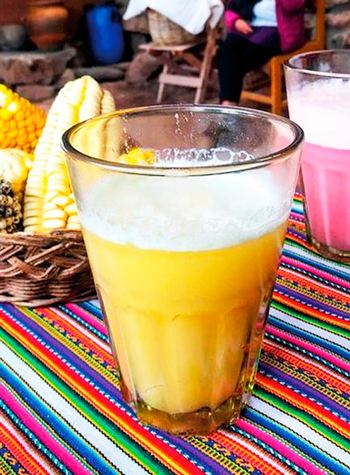
Frutillada: The Sweet Fusion of Tradition and Freshness in Cusco
With an essence similar to Chicha de Jora, Frutillada emerges as a delicious variant that incorporates Sacred Valley strawberries to give it a truly special flavor.
The preparation of Frutillada follows the basis of chicha de jora: the dry and sprouted yellow corn is ground and boiled, and the liquid is carefully filtered through baskets of reed and ichu reeds. However, the magic happens when the blended strawberry is added to the concoction, infusing a fresh and fruity touch.
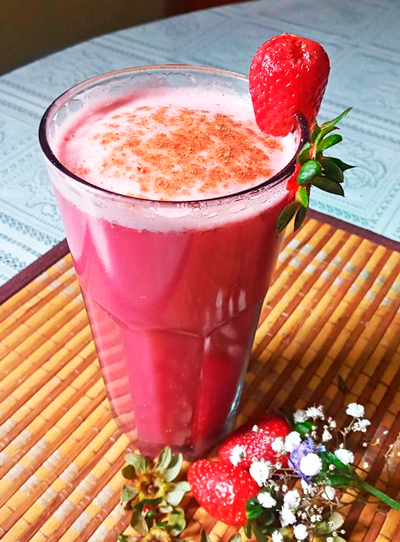
Chicha Morada: A Vibrant and Sweet Soft Drink the best accompaniment to the typical dishes of Cusco
Chicha Morada is a refreshing drink that stands out for its vibrant color and unmistakable flavor. This delicacy is made from the liquid obtained by boiling ears of purple corn, to which the citrus touch of lemon juice is added and sweetened with sugar.
The base of Chicha Morada lies in purple corn, a native variety that provides not only its distinctive purple tone, but also its nutritional properties. After boiling the cobs, a liquid is obtained that becomes the essence of this refreshing drink.
Whether accompanying a traditional meal or simply as a refreshment, Chicha Morada is a manifestation of Peru’s culinary diversity and authenticity.
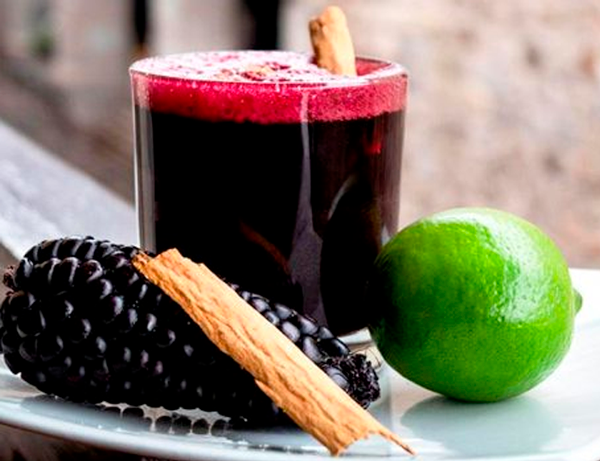
Coca Mate: Ancestral Infusion with Medicinal Properties from the Andes
Coca Mate is a unique infusion, obtained from the natural leaves of coca (Erythroxilon), which has been favored for centuries by Andean peoples. More than a simple drink, this infusion is considered a medicinal treasure, recognized for its properties in mitigating discomforts associated with altitude, such as dizziness and headaches.
In high altitudes, soroche or altitude sickness is a daily reality and Coca Mate becomes an indispensable ally. The infusion of coca leaves helps relieve symptoms caused by lack of oxygen, providing respite to those facing the demands of high altitudes.
In addition to its usefulness at altitude, Coca Mate is also appreciated for its properties known to soothe throat conditions and relieve stomach discomfort.
This tea infusion, rich in tradition and ancestral knowledge, is a testimony of the intimate relationship between the plants of the Andean region and the health of those who consume them.
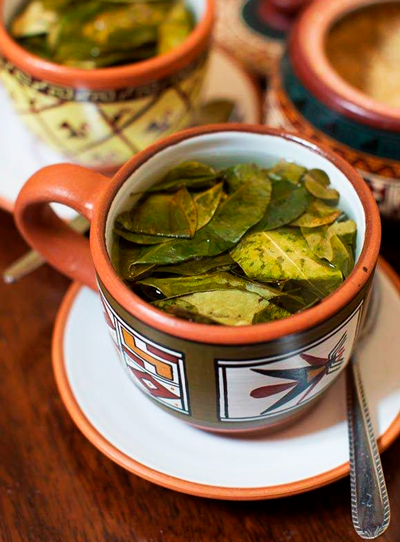
Pitted Tea: The Comforting Infusion with a Warm and Cheerful Touch
Pitted Tea is presented as a comforting and popular choice in frigid areas, where the climate invites you to seek warmth and joy in a cup. This unique tea infusion combines the comfort of tea with the vitality of cane liquor, creating an experience that goes beyond the ordinary.
At its core, Piteado Tea begins with a cup of common or oriental tea, offering the classic and comforting base expected of this drink. However, what elevates Té Piteado to a special level is the addition of a few glasses of cane liquor, a warm touch that transforms the tea drinking experience into something festive and joyful.
Whether to combat low temperatures or simply to add a festive touch to a quiet afternoon, Piteado Tea is a unique choice that invites you to enjoy life with every sip.

Common questions about the typical dishes of Cusco:
What was the common diet during the time of the Incas?
For the common people of the Inca empire, diet was largely vegetarian, reflecting a deep connection to the land and careful management of food resources. The meat, coming from camelids, ducks, guinea pigs, as well as game such as deer and vizcachas, was considered so precious that it was reserved exclusively for special occasions.
What fruits did the Incas eat?
The Incas enjoyed a variety of fresh, juicy fruits that they grew in the different regions of their vast empire. Some of the fruits that were part of their diet included: custard apple, guava, mango, banana, papaya, pineapple.
What was the drink of the Incas?
Chicha de jora, a craft beer made from fermented corn, held a distinguished place in Inca culture, being considered the sacred drink reserved for ceremonies and special events. This liquid essence not only quenched thirst, but also wove a spiritual thread that connected the Incas to their traditions and gods.
When do you eat Chiriuchu in Cusco?
Chiriuchu is a traditional dish of Cusco cuisine that is consumed mainly during the Corpus Christi festival. This religious celebration takes place on the second Thursday after Pentecost Sunday, which generally means that it takes place in the month of June.
What is the price of a Chiri Uchu dish?
The price of Chiri Uchu can vary significantly depending on where it is purchased as well as other factors, such as the location of the restaurant, the quality of the ingredients used, the prestige of the establishment and the time of year. Regular price during festivities is s/25.00
We recommend you take a street food tour in Cusco
Experience an exciting street food tour in Cusco, immerse yourself in the flavors, aromas and colors of Peruvian cuisine while trying a variety of delicious dishes prepared by local vendors. From tasty snacks to sweets, this tour promises to tantalize your palate and offer insight into Cusco’s rich culinary heritage. Get ready to savor the city’s authentic flavors as you explore its bustling markets and hidden culinary gems.”

